A combination of wet weather and work has meant that I haven’t been out and about around the Bellarine as much as I would like.
I drove to Anglesea and Point Addis one day and every time I stopped the car and went for a walk, the rain poured down in buckets. It was the first time I’ve been to the Surf Coast and not seen many birds at all.
I spotted two wedge-tailed eagles near Bellbrae, which was great, but no photo eventuated. I didn’t spot a rufous bristlebird at Point Addis or any blue-winged parrots at Anglesea Heath, so it was not a fruitful excursion to the area, but it was lovely to be there never-the-less.
Luckily I received some emails from Voice readers with their observations. Andrew sent a photo of a white-faced heron with a yabbie it caught at the wetlands near The Point estate.
White-faced herons are a common bird seen around Lake Connewarre and other wetlands, and even around farm dams, around the Bellarine Peninsula. They can also be seen foraging on coastal mudflats and around rockpools.
Andrew also sent a photo of a welcome swallow on a boat rope at Queenscliff. Welcome swallows apparently were named by sailors because if they noticed one of these birds when they were out at sea, they knew that they were approaching land. They are also a commonly seen bird around the Bellarine, and they give me a heart attack when I’m driving near the post office inOcean Grove as they weave around the traffic chasing insects to eat. Luckily, I haven’t hit one yet, as they are very nimble.
Andrew also saw a flock of parrots on the fence along the bike path through the marshes between Black Rock and Breamlea Roads. Andrew thought that these birds may have been the critically endangered orange-bellied parrot, but I think they were likely to be the very similar blue-winged parrot.
Orange-bellied parrots may mingle with blue-winged parrot flocks and this time of the year they fly to the mainland from Tasmania, but there are so few of them in the wild that they were unlikely to be the OBPs, although BWPs are also becoming less commonly seen and it’s great to spot a flock of them as well.
I received an email from Glenys, who regularly walks down the track from the Leopold lookout that is on the corner of Ash and Como Roads, to Lake Connewarre. Glenys was very excited to see a little white bird with flashes of creamy yellow on a few feathers.
It had a New Holland honeyeater flitting around it and flying off with it. Glenys thinks that the pure white bird was also a New Holland honeyeater, but a bird that lacked the colour pigment in its feathers. Unfortunately, this bird will be obvious to predators such as collared sparrow-hawks so it will be interesting to hear how long Glenys observes this bird around the area.








